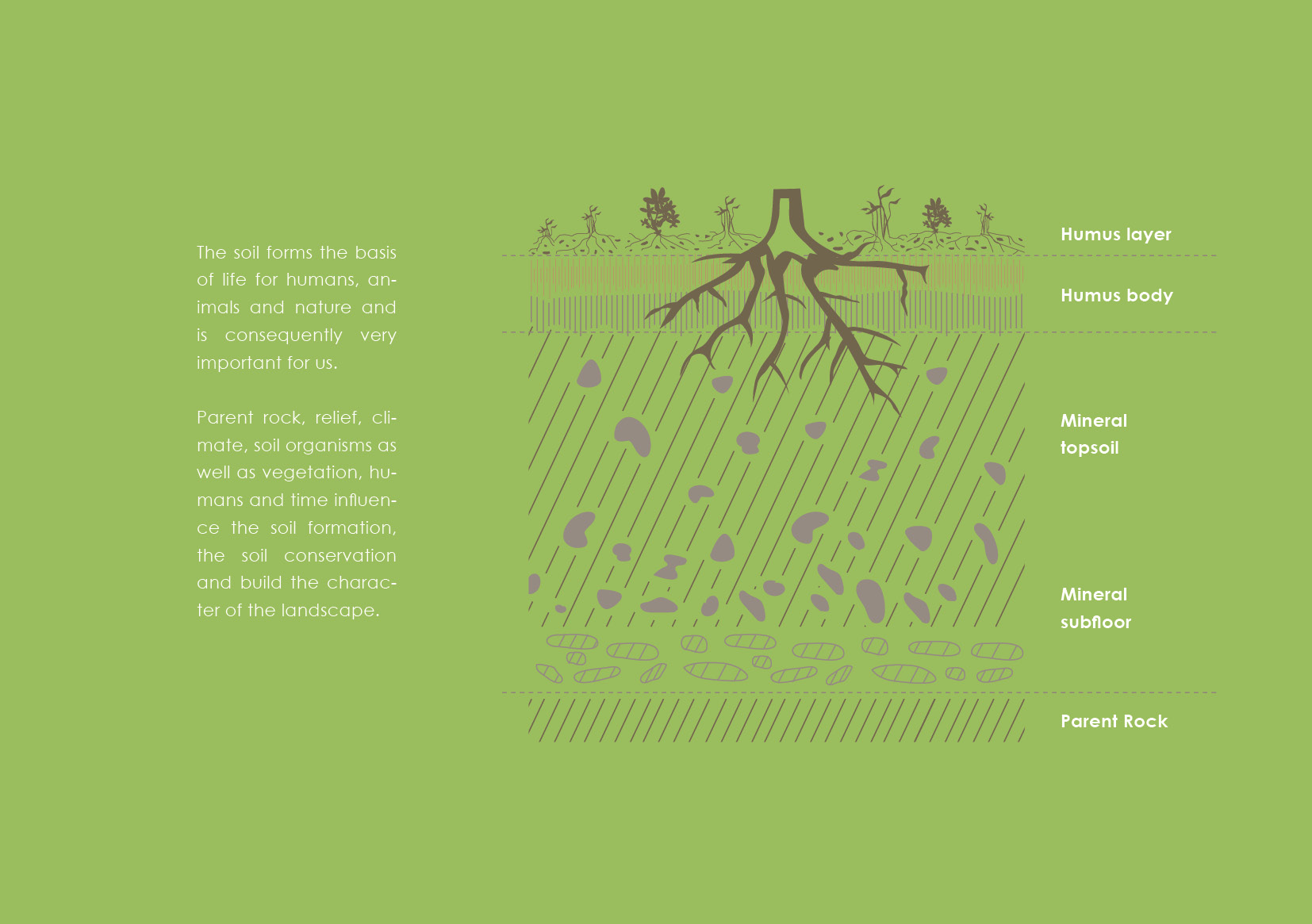Geology of our vineyards
When you enjoy an aged single vineyard wine, reflecting a special terroir, and you start thinking of old vintages, extreme longevity and matured life, you don‘t consider the age of the soils, where the vines thrive and how much (earth) history is hidden underneath.
In four sections we explain the formation of the rocks of our vineyards and show the continuous change of the landscape.

“OUR WINES REFLECT OUR TERROIR.”
“Patrizia & Erwin Sabathi”
A statement we use over and over again.
Terroir – this means the location, the climate, the soil and the geology of our vineyards in Southern Styria, or more specifically our single vineyards.

A journey through 400 million years of the earth‘s history
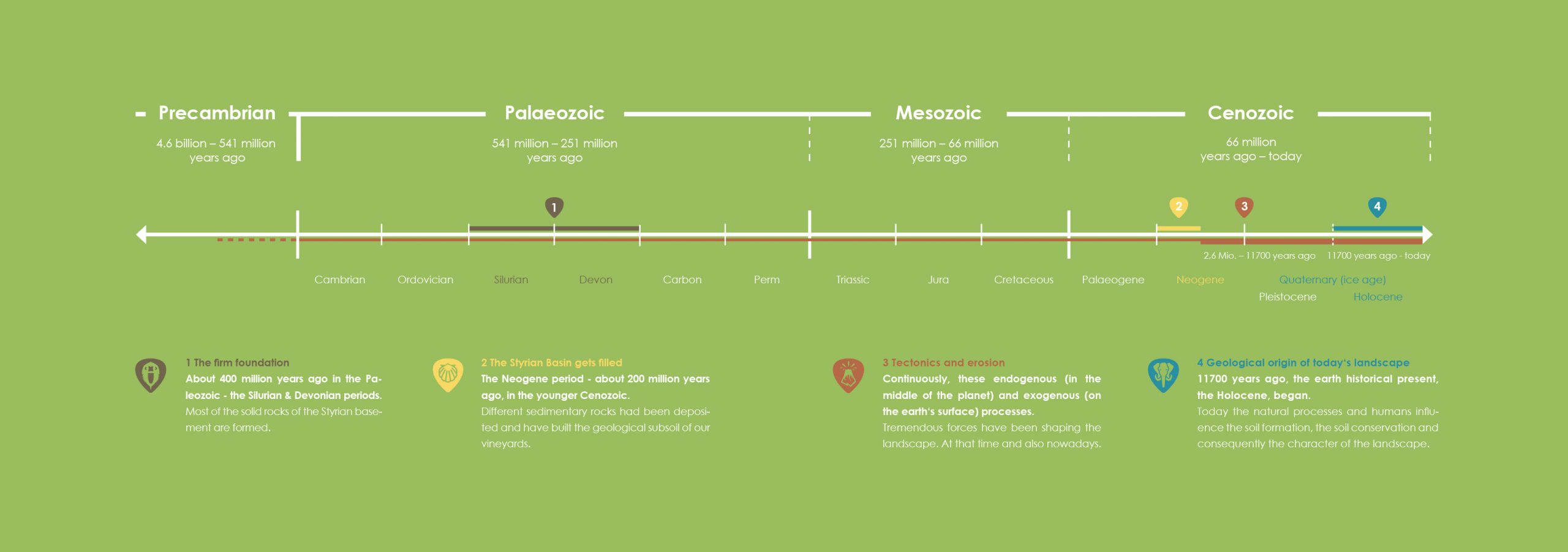
 The firm foundation
The firm foundation
The Paleozoic – the Silurian & Devonian periods
about 400 million years ago
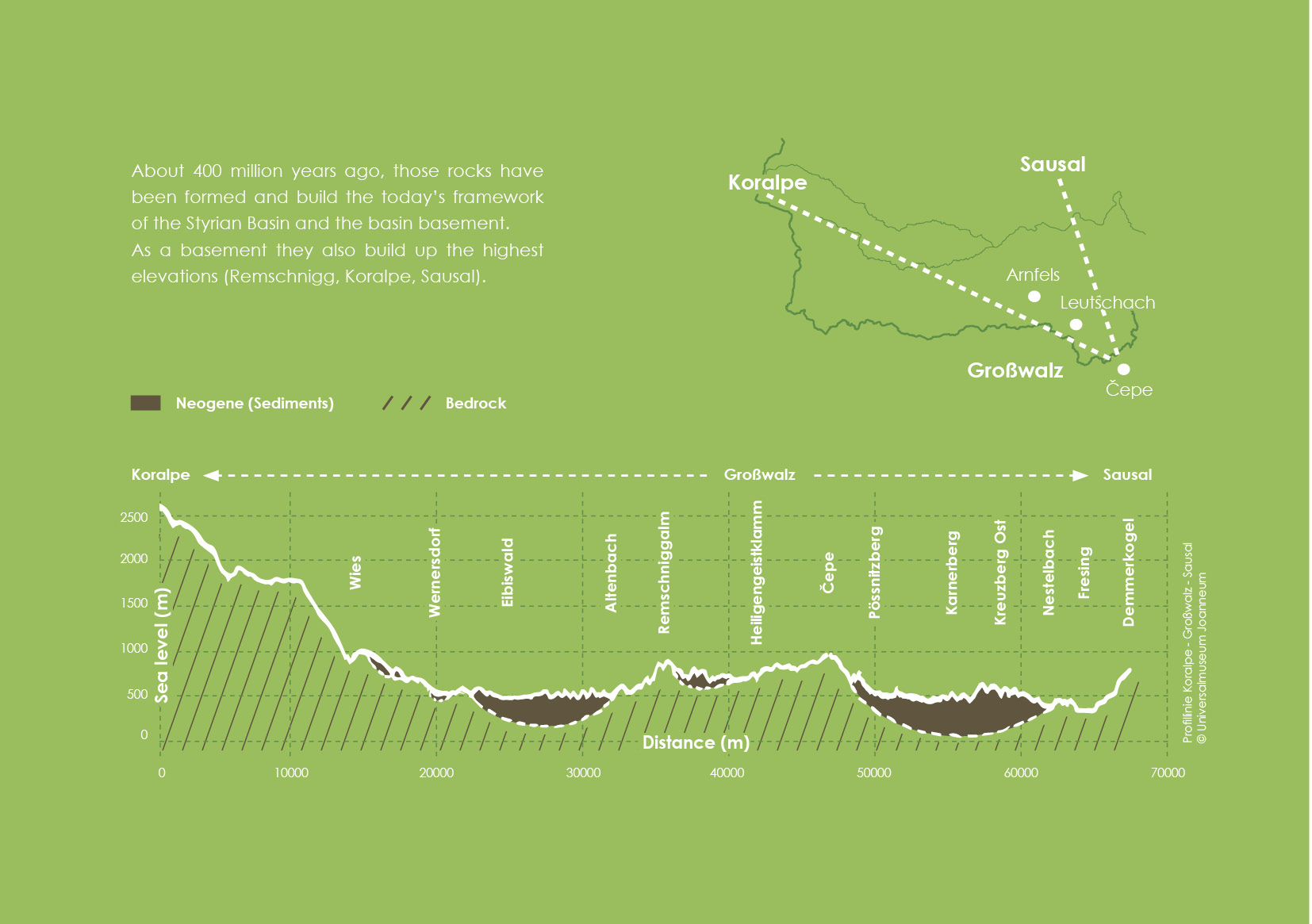
Most of the bedrock have been formed in the
Palaeozoic era. They have been sandy-clay sediments with interbedded volcanic rocks and chalky stones, which were deposited in a sea south of the equator. During the last 400 million years, parts of these sediments finally reached their present position due to
plate tectonic processes (shifting of earth plates). They build up for example the Remschnigg, the Koralpe and the Sausal, today.
During their journey, some rock units have been
lowered several times deep into the earth‘s crust. They have been transformed by different types or pressure and temperature into diabase, slate, gneiss, marble, amphibolite and eclogite. Pegmatites and granitic rocks also prove the intrusion of rock melts into these rock units.
Other rocks, such as chalky stones of the Graz Paleozoic, have hardly been overmodified. This is documented, together with the still preserved fossils (e.g., corals), by their original formation in a warm sea.
The long transport route and the different tectonic processes have left traces: intensive folding and faults as well as the juxtaposition of different rock units. Only
small remnants present the Mesozoic era (chalky
stones, dolomites, conglomerates).
Most of these geological documents of time have
been removed a long time ago.
The rocks of the „firm foundation“ also build the source rocks of the sediments, which the Styrian Basin has been filled with.
 The Styrian Basin gets filled
The Styrian Basin gets filled
The younger Cenozoic – the Neogene period
approx. 200 million – 16 million years ago
With the uplift of the Alps, a massive reshaping of the landscape began about 20 million years ago. These also had led to the formation of large basins (e.g., Styrian -, Vienna -, Pannonian basin).
Intensive magmatic activity accompanied these processes. The sediments provide us a marine spreading in these basins, which has taken several million years.
The West Styrian Basin is bordered in the south by the Remschnigg-Poßruck, in the west by the Koralpe and in the east by the Sausal.
The subsidence of this basin was accompanied by the dumping of coarse clastic, poorly rounded, crystalline components. Above this, predominantly finer-grained sediments follow, which are also coal-bearing.
These deposits can be found in the region around Eibiswald today.
After that, a phase is documented with the formation of a delta. Finally, the whole region has been flooded by the advancing sea. In addition to fine-grained deposits (silt, sand), individual interbedded gravel layers provide evidence of submarine flows.
Some fossil finds (e.g., sea urchins, shell fragments of bivalves, plant remains as well as foraminifera and trace fossils) attest a depositional area. That has been initially formed as a deep-water area but slowly got flattened.
Some coarse gravels/blocks and sands are the youngest extant sediments in the region. Some of these deposits carry fossils (e.g., oysters, spire snails).
They may have been contemporaneous with the reeflike formations of the shoals to the east.
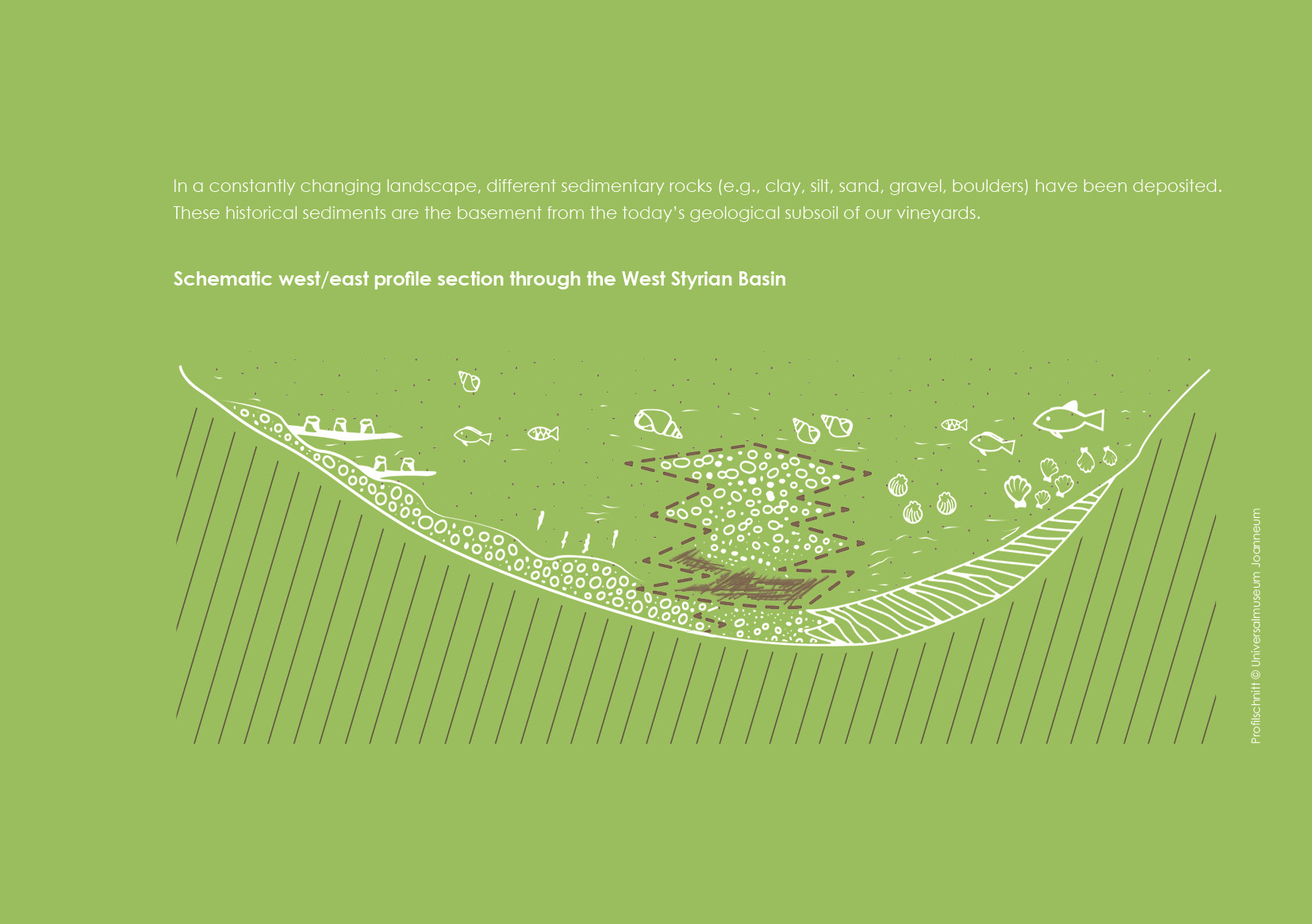
 Tectonics and erosion
Tectonics and erosion
There always was and now still is /
In this section: periods since the Neogene
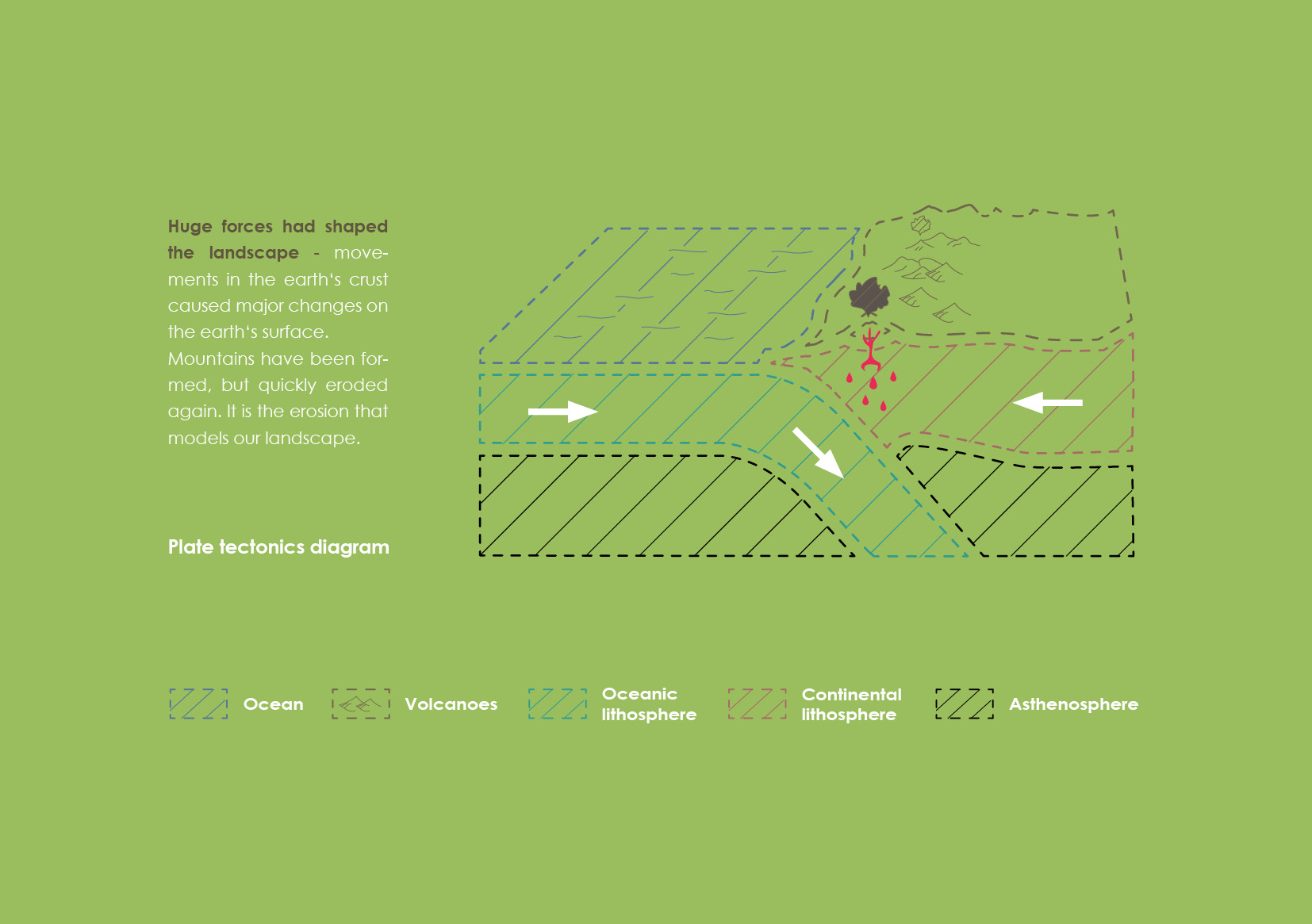
After several hundred meters of thick rock sequences have been deposited over a period of several million years, an uplift phase finally occurred in the Styrian Basin that continues until now.
These tectonic forces also caused an inclination of the deposited layers.
Now those rivers, which have filled the West Styrian Basin in the final phase with rocks from the mountains, began to cut into the previously sedimented deposits.
In addition to the major tectonic movements, the climate also has a significant impact on the landscapeshaping processes now taking place. Especially the repeated alternation of cold and warm periods (in the Quaternary ice age) during the last 2.6 million years, had formed the landscape.
Phases with little water (snow, glaciers) alternate with periods of large water supply (meltwater). During that time, increased erosion could also take place. Especially at the edge of the bedrock, the streams „cut“ into the rocks and formed narrow gorges, ravines and ditches. Along the river courses, terraces have been developed on the slopes depending on the water supply.
At present, the removed rock material is temporarily stored in the wide valley areas before they start moving again during floods. The inclined alternating layers of fine and coarse-grained layers also cause mass movements because of the different water permeability.
Signs of slope creep and landslides can be observed in many places.
 Geological origin of today‘s landscape
Geological origin of today‘s landscape
Cenozoic era / the Holocene
from 11700 years ago until today
Geological processes usually take place in periods of time that are very difficult for us to comprehend.
Even recent changes in the landscape can be hardly remembered for generations. In our regions, the vegetation is particular important for the particularly landscape-shaping significance. Blurred are the transitions from the still sparsely preserved natural landscapes to the dominant cultural landscapes.
The soil forms the basis for the life for humans, animals and nature and is consequently very important for us.
Parent rocks, relief, climate, soil organisms as well as vegetation, humans and time influence the soil formation, the soil conservation and also build the character of the landscape.
Southern Styria has been a wine-growing region for
centuries.
Vineyards are cultivated permanently for many years.
It is therefore up to winegrower to maintain a high level of biodiversity within the framework of quality-oriented and sustainable management. He supports those factors that ensure optimal development of the vines.
